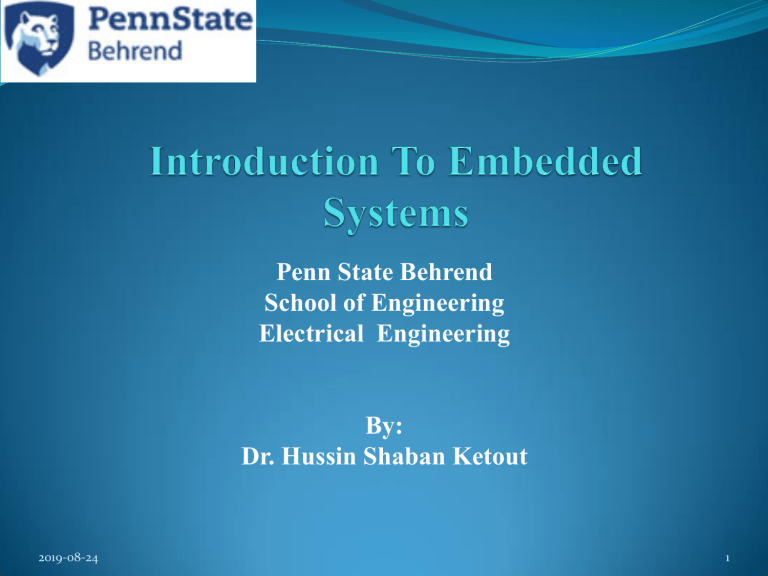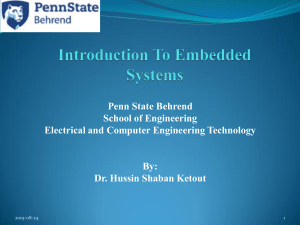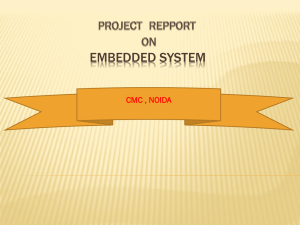
Penn State Behrend School of Engineering Electrical Engineering By: Dr. Hussin Shaban Ketout 2019-08-24 1 Outlines Objectives What is Embedded System? Examples from Real Life Why Do we need Embedded Systems? Embedded System Architecture Microprocessor & Microcontroller Course Components Q&A (Discussion) 2019-08-24 2 Objectives Introducing the Embedded Systems Embedded Systems in Our Daily life Importance of Embedded Systems Architecture of Embedded Systems Microprocessor & Microcontroller Architecture of Mp & Mc 2019-08-24 3 Introducing The Embedded Systems What is the Embedded System ? • An embedded system is a combination of hardware and software that designed to carry out a certain task or tasks, meaning it has a specific function. • The Software is usually known as FIRMWARE, • That is EMBEDDED into the HARDWARE 2019-08-24 4 Introduction Cont. Examples in Day Life: 2019-08-24 5 Introduction Cont. Example in Day Life: 2019-08-24 6 Introduction Cont. Example in Day Life: 2019-08-24 7 Introduction Cont. Example in Day Life: 2019-08-24 8 Introduction Cont. Why do we need embedded systems? 1. Embedded systems are application specific & single functioned; 2. To reduce the size and cost of the product 3. Increase the reliability and performance 4. Give the output within the time limits 5. Some embedded systems are mass-produced, benefiting from economies of scale. 2019-08-24 9 Introduction Cont. Embedded System Block Diagram? 2019-08-24 10 Why do we need to learn about Microprocessors/Microcontrollers? The microprocessor is the core of computer systems. Nowadays, many communication, digital entertainment, portable devices, are controlled by them. A designer should know what types of components he/she needs, ways to reduce production costs and product reliability. The Necessary Tools for a Microcontroller CPU: Central Processing Unit I/O: Input /Output Bus: Address bus & Data bus Memory: RAM & ROM Timer Interrupt Serial Port and/or Parallel Port Microprocessors: General-Purpose Microprocessor CPU for Computers No RAM, ROM, I/O on CPU chip itself Example:Intel’s x86, Motorola’s 680x0 CPU GeneralPurpose Microprocessor Many chips on mother’s board Data Bus RAM ROM I/O Port Address Bus General-Purpose Microprocessor System Timer Serial COM Port Microcontroller A smaller computer On-chip RAM, ROM, I/O ports... Example:Motorola’s 6811, Intel’s 8051, Zilog’s Z8 CPU RAM ROM A single chip I/O Port Serial Timer COM Port Microcontroller Microprocessor vs. Microcontroller Microprocessor CPU is stand-alone, RAM, ROM, I/O, timer are separate Designer can decide on the amount of ROM, RAM and I/O ports. Expansive General-purpose Microcontroller • CPU, RAM, ROM, I/O and timer are all on a single chip • Fixed amount of on-chip ROM, RAM, I/O ports • For applications in which cost, power and space are critical • Single-purpose • Inexpensive Microcontroller Block Diagram External interrupts Interrupt Control On-chip ROM for program code Timer/Counter On-chip RAM Timer 1 Timer 0 CPU OSC Bus Control 4 I/O Ports P0 P1 P2 P3 Address/Data Serial Port TxD RxD Counter Inputs Course Components Introduction To Embedded Systems C Language Developing Firmware & Hardware (Embedded Systems) Buying the required Hardware Developing the software to operate the hardware Thank you any Questions? 2019-08-24 18



